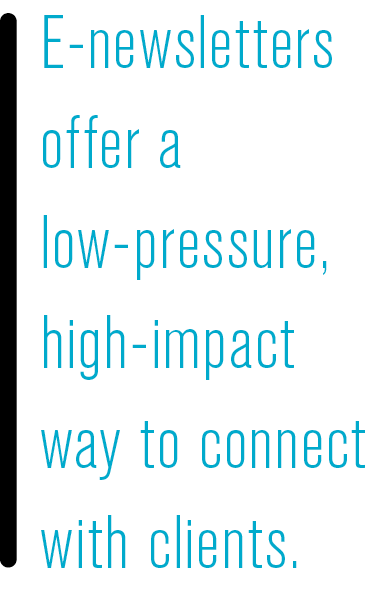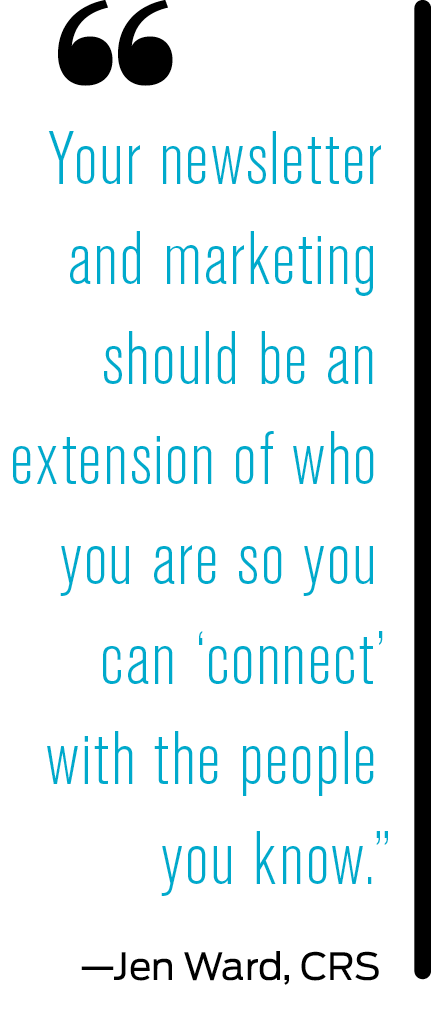Advice on how agents can strengthen their e-newsletter offerings for clients
By Megan Craig
REALTORS® know they need to stay top-of-mind to be competitive in the industry. But the marketing tactics you’ve used for years may not be doing the trick anymore.
Looking for another way to subtly market yourself all year long? E-newsletters offer a low-pressure, high-impact way to connect with clients.
 Jen Ward, CRS, REALTOR® at Cummings & Co. Realtors in Lutherville, Maryland, started sending e-newsletters more than 10 years ago. She wanted another way to remind clients of her expertise and dedication to their home purchase needs and beyond, and e-marketing appealed to her because of its simplicity. Ward drops her e-newsletter right in the middle of the month, every month. The newsletters include a mix of tips for homeowners, action items for the month and some more personalized, funny, “slightly silly” stuff (like song lyrics or a meme) to keep people engaged.
Jen Ward, CRS, REALTOR® at Cummings & Co. Realtors in Lutherville, Maryland, started sending e-newsletters more than 10 years ago. She wanted another way to remind clients of her expertise and dedication to their home purchase needs and beyond, and e-marketing appealed to her because of its simplicity. Ward drops her e-newsletter right in the middle of the month, every month. The newsletters include a mix of tips for homeowners, action items for the month and some more personalized, funny, “slightly silly” stuff (like song lyrics or a meme) to keep people engaged.
“It’s just another touch point, so that I’m in touch with my people at least once a month. Whether they read it or they don’t, I’m at least in their inbox,” she says.
Consistent contact
REALTOR® Kate Johnston, CRS, of Key Realty in Redmond, Washington, had long mailed out newsletters but added a digital version to her marketing repertoire around 2017. She aims for consistency: Her newsletters always contain some real estate news, information on places to go and things to do in the community, and a local business spotlight.
In addition to acting as another point of contact for her clients, Johnston says she loves that sending an e-newsletter offers her real-time data on how many and which clients see her content.
 “You can see the open rate and the instant response,” she says.
“You can see the open rate and the instant response,” she says.
She uses that data to better plan for distribution. For example, she doesn’t send her e-newsletter on Monday mornings because people’s inboxes are already flooded from the weekend. Analysis of the data told her aiming for the end of the week meant a better email open rate.
Johnston is also able to use that information to keep her contact list updated.
“Did I get a bounce back? Did their email change or is it typed in the database wrong?” she says. “I’m able to be more selective, to keep the list really tight.”
Maintaining a solid contact list and being able to consistently communicate with that list is important when sending e-newsletters, Ward says. She uses her CRM, which helps her stay organized and designate specific times for the e-newsletters to be sent.
But being consistent is different from being boring, Ward warns. Be sure you’re changing the advice and the types of articles from month to month, year to year, so your clients don’t start to ignore your emails.
“I always put in something kind of fun, and that’s when people start looking at it,” she says.
Designing for impact
Content isn’t the only important part of a newsletter; you also need to consider the design and layout of the information.
Ward has used several programs over the years to give her newsletters a polished look:
- Mass email programs like Constant Contact and Mailchimp allow you to design a newsletter within those programs before mailing out to your list.
- An online hosting service like Issuu will allow you to create and preserve a digital publication and offers newsletter creation software.
- Many CRMs come with newsletter creation components. Johnston takes it one step further: She pays a designer to make her newsletters shine.
Know your audience—and help them get to know you
It helps to have an audience, Ward knows, since that allows her to curate the messages and stories in her e-newsletters.
“I know my people—it’s going out to my database—so I like to find articles that will interest them,” she says. “But it’s also a chance for me to connect through my personality.”
Ward is a professional agent, but she’s also fun-loving, she says, and her clients know (and love) that about her. That’s why including emojis and song lyrics in between reminders to clean their gutters works for her. She also includes a personal message, reminding people that she’s always around to talk about the market or answer real estate-related questions.
Johnston aims to give her clients “sticky content”—tips, tools, advice and articles that will stick with them long after they’ve opened her e-newsletter.
“My goal is that when I stop at somebody’s house, they still have that guide I emailed out hanging on their refrigerator,” she says. “That’s how I know it worked; that’s how I know I’ll be top of mind and memorable.”
Grab your reader’s attention
Ward, used to send out her monthly e-newsletters with basic, boring subject lines—“What’s Happening in Baltimore Real Estate,” for example—but realized that wasn’t enticing anyone on her list to actually open the emails.
Basic data from her CRM showed an open rate around 10%, “and that just wasn’t going to work,” she says.
Now she uses song lyrics so her subject line will stick out in the long list of emails her clients receive every month. Sometimes it’s a throwback. Sometimes it’s from a contemporary artist, like Harry Styles or Nelly. For July, she used “Hot in Herre;” in September, she used the iconic song “September” by Earth, Wind & Fire.
As soon as she started adding personality to her e-newsletter subject lines, her open rate jumped from 10% to about 40%.
“It sparks something, and it just seems to get people’s attention,” she says. “They’re like, ‘Jen’s sending another crazy email; I want to take a look at that,’ which is fantastic. Your newsletter and marketing should be an extension of who you are, so you can ‘connect’ with the people you know.”
Take advantage of the monthly, CRS-branded newsletter, “Your Home,” created for CRSs to share with clients. Download today at CRS.com/resources/your-home-newsletter or on the right sidebar of TRSmag.com.
Photo: iStock.com/juststock








